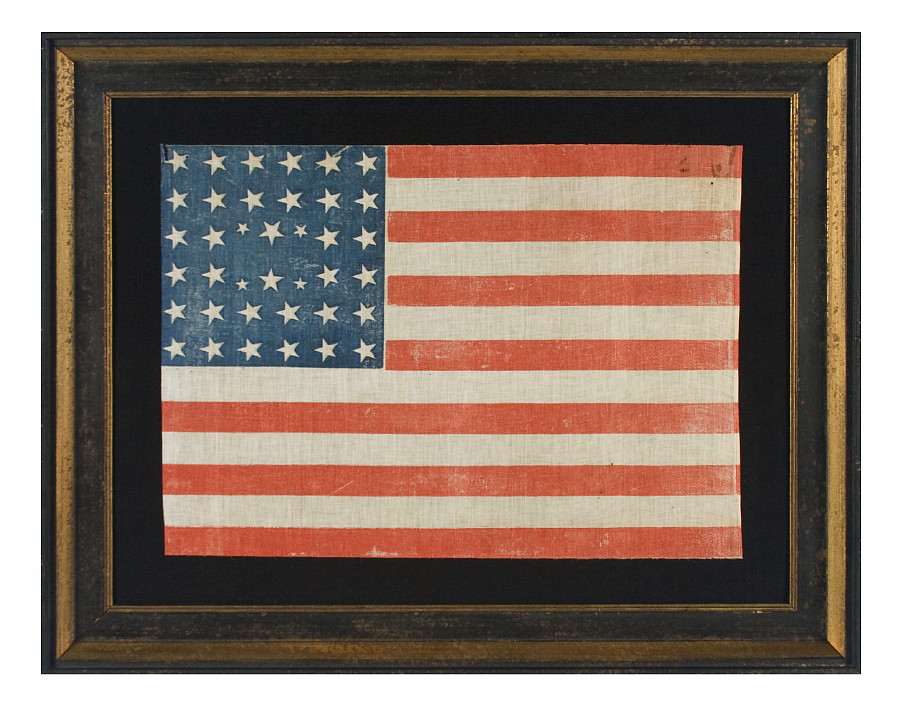
| |
38 STARS IN AN EXTREMELY RARE LINEAL CONFIGURATION THAT HAS 4 TINY STARS EMBEDDED IN THE PATTERN, 1876-1889, COLORADO STATEHOOD |
|
| Available: |
Sold |
| Frame Size (H x L): |
31" x 38.25" |
| Flag Size (H x L): |
20" x 27.25" |
|
| Description....: |
|
38 STARS IN AN EXTREMELY RARE LINEAL CONFIGURATION THAT HAS 4 TINY STARS EMBEDDED IN THE PATTERN, 1876-1889, COLORADO STATEHOOD:
38 star American national parade flag, printed on coarse, glazed cotton. The stars are arranged in a very rare square medallion that consists of two consecutive squares of stars that surround an unusual center grouping. Note how all of the stars along the borders are the same size and that all are canted slightly to one side on their vertical axis. The center stars, by contrast, are arranged in two groups of three, the points of which face one-another like knights on a chess board. Each group has a larger center star (the same size as those on the perimeter), flanked by two smaller stars, one on either side. Note how the six center stars do not line up with those beside them, and that because of their placement, a slight gap was created in the center of the square canton.
I have explored several theories about the use of the smaller stars, but none provides a certain answer. The most plausible among them is that the flag was made in an earlier period so that the 4 small stars were anticipatory, meaning that they represented territories that had not yet become states. If this was true, then this and other known flags may have been made as 34 star flags, with 4 little stars for the Washington, Nebraska, Utah and New Mexico Territories that existed in 1860.
This isn't the only known 38 star design that employs 4 little stars among a field of larger ones. A very similar variety exists in roughly the same size, printed on silk instead of cotton. Its stars are arranged differently, but there are also 4 small ones placed roughly in the center of a lineal field. Yet another variety exists in which there are 4 small stars outside the basic pattern. The overall design of this flag, printed on cotton, may represent a beehive.
All of the above are extremely rare, which does suggest an earlier date, but it is my opinion that the flags date to 1876 for two primary reasons. One, while the fabrics and printing used in their construction doesn't completely preclude 1861, it does suggest the later date. Chief among these is gold fringe that exists on one of the silk examples, which does not appear to be of Civil War vintage. Another is the existence of a 38 star variety that has 6 tiny stars buried in a lineal field of larger ones. This style is certainly 1876 based on colors and fabrics.
Whatever their purpose, this very rare group of flags that have little stars set firmly apart within lineal configurations are a great curiosity in flag collecting. For this reason they are very important objects in flag collecting. Further, there are only a couple of known parade flags in this exact style. I know of fewer than five.
The 38th state, Colorado, received its statehood on August 1st, 1876. This was the year of our nation's centennial of independence from Great Britain. Although 37 was the official star count for the American flag in 1876, flag-making was a competitive venture, and no one wanted to be making 37 star flags when others were making 38's. It is for this reason that 38 and 13 stars (to represent the original 13 colonies) are the two star counts most often seen at the Centennial International Exposition, the six-month long, World's Fair event, held in Philadelphia in honor of the anniversary. The 38 star flag became official in 1877 and was generally used until the addition of the Dakotas in 1889.
Mounting: The flag has been hand-stitched to a background of 100% cotton twill, black in color. The black fabric was washed to remove excess dye. An acid-free agent was added to the wash to further set the dye and the fabric was heat-treated for the same purpose. The mount was then placed in a black-painted, hand gilded and distressed Italian molding. The front is U.V. protective acrylic.
Condition: There is minor dye loss throughout. There is minor fabric loss at the top of the hoist end and there are a couple of tiny holes. This is the bleed side of the flag, so it is a bit lighter as a result of the printing. There is very minor staining in the upper, fly end corner. Many collectors prefer early flags to show their age and history of use. In addition, the fact that this flag is the only known example means that almost any condition is acceptable, especially when the flag presents as well as this one does. |
|
|
|
| Collector Level: |
Advanced Collectors and the Person with Everything |
|
| Flag Type: |
Parade flag |
|
| Star Count: |
38 |
|
| Earliest Date of Origin: |
1876 |
|
| Latest Date of Origin: |
1889 |
|
| State/Affiliation: |
Colorado |
|
| War Association: |
1866-1890 Indian Wars |
|
| Price: |
SOLD |
|
| |
Views: 2987 |
|
|
|

